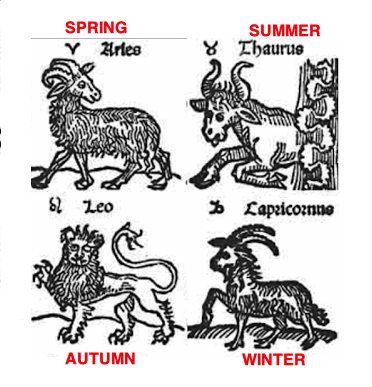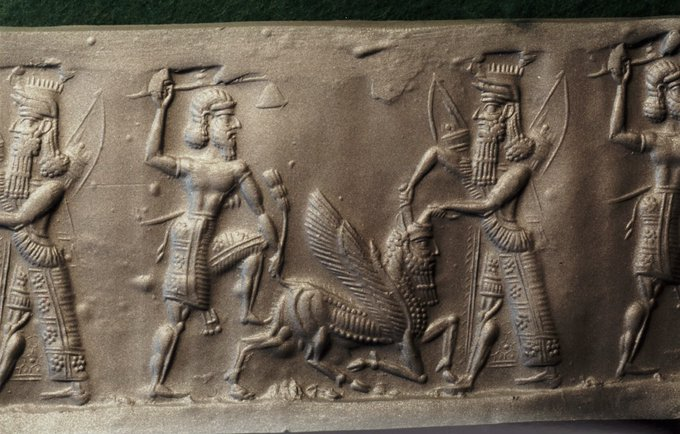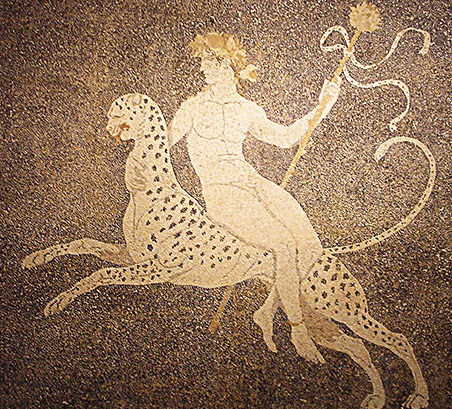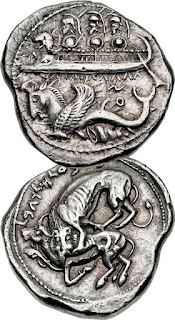This is one of the most amazing objects I have seen in a long while...Roman sarcophagus depicting the legend of Ariadne, Theseus and Minotaur. Found at Capranica, near Rome, dated 130-150AD. Currently in Met Museum...
Why is this object so amazing?
Well, because, through animal and plant calendar markers, it shows us what the legend of Ariadne, Theseus and Minotaur actually means...
But to see this, we first have to correct one error that the carvers of the sarcophagus have made...
Here is the beginning of the description from the Met page and the error:
"On the lid...winged erotes drive chariots drawn by animals associated with the four seasons: bears with spring, lions with summer, bulls with fall, and boars with winter"
Hmmmmmmm...
Bull has always been associated with summer (May/Jun/Jul). Summer even starts in Taurus...
Taurus, an ancient animal calendar marker marking the beginning of the calving season of Eurasian wild cattle...I talked about this in many of my posts, like "Cow and calf ivory", "Lotus and papyrus", "Bull carrying grannary", "Foundation peg of the goddess nanshe", "Cypriot stamp seals with cow and calf"...
Lion has always been associated with autumn (Aug/Sep/Oct). Autumn even starts in Leo...Leo, an ancient animal calendar marker marking the beginning of the mating season of Eurasian lions...I talked about this in many of my posts, like "Sphinx", "Origin of griffins", "Two lions killing bull", "Lions of Delos", "Angra Mainyu"...
Well, saying this, if lion is depicted on its own, without a bull, it does represent old summer, the hot half of the year. Particularly if it's paired with an animal that represents old winter, the cold half of the year, like a boar. I talked about this in my post "Admetus"...
But if a lion is depicted with a bull, the bull is always the symbol for summer, and lion is always the symbol for autumn. And lion killing bull is the symbol for Jul/Aug, when autumn (lion) ends (kills) summer (bull). Like on this coin from Cilicia, dated to 361-334BC
I talked about this in many of my posts, like "Mystery seal", "Two lions killing bull", "Lion killing bull under date palm"...
As a matter of fact, once we swap the places taken by bulls and lions, every animal on the lid is an animal calendar marker, marking the mating or birthing season of the depicted animal, chronologically from left to right:
Leopard, mating Jan/Feb. A well known animal calendar marker for the end of winter, beginning of spring. I talked about this in many of my post, like "Oldest narrative scene", "Vessel from Tepe Hissar", "Harness ring from Luristan", "Elamite copper bowl", "Patera of Rennes", "Lod mosaic", "Leopard", "Furious maenad", "Maenads with hare", "Thyrsus", "Woman and pitcher"...
Bear, emerging from hibernation with cubs, Feb/Mar. A well known animal calendar marker for spring. I talked about it in these two articles "Overpowering" and "Khafajeh vase"
Then we have bull, Apr/May, which is, as I explained above, a well known symbol for summer.
And lion, Jul/Aug, which is, as I explained above, a well known symbol of autumn.
I talked about symbols of the seasons in my post "Symbols of the seasons"...
Then we have wild boar, mating Nov/Dec/Jan. A well known symbol for winter. I talked about this in many of my posts, like "Wolf vs snake", "Sirens", "Vettersfelde treasure", "Summer and winter BMAC seals", "Roast pig for Christmas", "Calydonian boar", "Abduction of Persephone", "Double headed eagle"...
And finally Ibex goat, mating Nov/Dec/Jan. Also a well known symbol for winter. I talked about symbolism of ibex goats in many of my posts, like "Pitys", "Goat in European culture", "Patera of Rennes", "The tree of life/light", "Lachish animal calendar", "Feast plaque from Louvre", "Green pastures", "Problems with Abzu", "Relief from Dur Sharrukin", "Goatfish", "Flamingos from Susa", "Goat carrier", "Iranian goat of rain", "Strider", "A vessel from Tepe Hissar"...
Between bull and lion is a date palm tree. This is very important for determining where this iconography comes from...Because it is in Mesopotamia that date harvest season starts at the end of summer (bull) and beginning of autumn (lion)...I talked about this in many of my posts, like "Date beer", "Lion killing bull under palm tree", "Adda seal"
Here is the sarcophagus lid with the corrected order of animals:
Now that we know that this front, from left to right depicts a solar year (spring, summer, autumn, winter) let's have a look at the front of the sarcophagus:
"On the front, four erotes bear seasonal garlands composed of flowers, wheat, grapes, pomegranates, and laurel."
No link between the plants and seasons of course. So here it is:
Flowers - flowers bloom in spring (kind of obvious 🙂)
Wheat - wheat is harvested in summer
Grapes - grapes are harvested in autumn
Pomegranates - pomegranates are harvested in winter
But what about laurels?
Until today, I didn't know that laurel berries are also harvested during the winter, in November...They're high in lauric acid, a potent antiseptic, and berry oil has historically been used a such...But I would expect to see some berries depicted among the leaves here and there.
So I thought that maybe these could be olive leaves, considering that olives are harvested in winter, starting from November...But I would expect to see some olives depicted among the leaves here and there.
Eventually I thought that these could be pinecones, also harvested during the winter, starting from November...But again I would expect to see small cones depicted on an evergreen branch here and there...
So the jury is out on this one, but regardless, any of them is a good plant calendar marker for winter...
So here is the sarcophagus with all the animal calendar markers ordered correctly and linked to seasons and all the plant calendar markers linked to seasons:
Now question: Why are Erotes depicted riding all these animal calendar markers and holding garlands of all the plant calendar markers?
Cause of sex...Eros is sex personified. Human, animal, plant...And sex produces babies and fruit...
And all these animal calendar markers mark either mating or birthing season of the depicted animals. And all the plant calendar markers mark either flowering or ripening and harvesting seasons of the depicted plants...
But all of this I talked about before. To read more about ancient animal and plant calendar markers, start here…then check the rest of the blog posts related to animal calendar markers I still didn't add to this page, and finally check my twitter threads I still didn't convert to blog post...I am way behind now...
Finally...The big moment...The story of Ariadne, Theseus and Minotaur, how it is laid on top of this depiction of a solar year. Here is the description from the Met:
"Between the swags are three episodes from the myth of the Greek hero Theseus:
1. Ariadne giving a thread to Theseus at the entrance to the labyrinth.
2. Theseus slaying the Minotaur.
3. Ariadne abandoned on the island of Naxos, where she will be awakened by Dionysos and become his bride".
Now, I don't know if this is a coincidence, but Theseus kills Minotaur, The Bull-Man, right under the palm tree, which marks Jul/Aug, the end of summer symbolised by a bull...Basically the death of the Bull of summer...
Usually depicted as Lion (autumn) killing Bull (summer)
Also known as Killing of the Bull of Heaven...I already talked about it in these posts: "Killing of the bull of heaven", "Is that you Gilgamesh", "Assyrian winged dragon", "Winged superhuman hero", "Mystery seal", "Under the blazing Sun Sirius"...
Let me answer my own question: I don't think that any of this is a coincidence...I mean the abandonment of Ariadne is depicted under the beginning of winter...At the time when Dionysus, the winter sun, arrives...Dionysus and Ariadne, Rhodes, 4th c BC, currently in the Louvre...
Few articles about the Dionysus, maenads and thyrsus and the significance of floral and faunal symbols associated with them and their link with winter: "Leopard", "Furious maenad", "Maenads with hare", "Thyrsus", "Woman and pitcher", "Patera of Rennes", "Lod mosaic"...
Knowing now how the Theseus legend is linked to the calendar, I would then venture to say that the 7 girls and 7 boys, sacrificed to Minotaur, are Pleiades...In Greek mythology they are known as 7 sisters. In Slavic mythology they are known as 7 brothers...So that fits...
The heliacal rising of pleiades, during the Greek Bronze and Early Iron Age, fell in Apr/May...In Taurus...So every year, 7 sisters/brothers, rose with the sun, and were swallowed by the summer sun at the beginning of the summer, symbolised by a bull...Swallowed by Taurus...
Theseus meets Ariadne, when he arrives to Crete as one of the sacrificial victims...The moment the sacrificial victims (7 brothers/sisters = Pleiades) enter the labyrinth, is the end of spring, beginning of summer (Apr/May)...In Taurus...
So Ariadne gives Theseus the sword with which he kills Minotaur during spring...Before he enters the labyrinth at the beginning of summer, Apr/May, in Taurus...Which is exactly where this scene is depicted on the sarcophagus...
So here is the story of Ariadne, Theseus and Minotaur with annotations...
I don't know how many times I asked this, but HOW AMAZING IS THIS??? There is no way in hell, that this is a coincidence...Whoever made this sarcophagus in the 2nd century AD was transmitting ancient knowledge, albeit a slightly garbled version of it...VERY OLD!!!
And this secret message remained hidden, in plain sight, until today...Well maybe someone else already figured all this out before me, and if so, please let me know...
That's it for tonight. My wife is nagging me to go to bed. Sweet dreams folks 🙂
PS: Just thought of something. In the story about Theseus, he:
spring (seduces Ariadne)
summer (wonders around the labyrinth and kills Minotaur)
winter (abandons Ariadne to Dionysus)
What happened during autumn?
autumn (sailing away)...
Autumn starts in Jul/Aug...And according to Hesiod:
"Fifty days after the solstice,
when the season of wearisome heat is come to an end,
is the right (best) time for men to go sailing"
I talked about this in my post "Trojan horse" and "Tetradrachm from Byblos"...
So that's that. I will finish this post with this coin from Cnossos (500—431 BC) with representation of Minotaur on the averse side and cross-shaped labyrinth on the reverse side with the sun in its centre. Remember summer, the sun dominated part of the year, starts in Taurus...I talked about the "solar bull" in many of my posts, like "Solar bull", "Menorah from Nippur", "Human bull hybrid", "Maran", "Theseus ring"...
























Zanimljivo i poučno kao uvek.
ReplyDeleteSamo, gde se Mitra u ovoj priči izgubio?
Mitra ili Mehr, odnosno egipatski Mihos. Jer Mitra bi morao biti lav, zar ne?
A onda sekira labris, labirint, lavirint dolaze po lava.